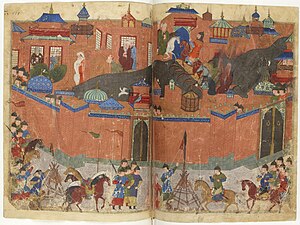| Siege of Baghdad | |||||||||
|---|---|---|---|---|---|---|---|---|---|
| Part of the Mongol invasions and conquests | |||||||||
 Depiction of Hulegu's army besieging the city, c. 1430 | |||||||||
| |||||||||
| Belligerents | |||||||||
| Ilkhanate (Mongol Empire) | Abbasid Caliphate | ||||||||
| Commanders and leaders | |||||||||
| Strength | |||||||||
| 138,000–300,000,[a] including auxiliaries from Armenia, Georgia, China and elsewhere in the empire | 50,000 | ||||||||
| Casualties and losses | |||||||||
|
200,000 killed (according to Hulegu) 800,000–2,000,000 killed (Muslim sources) | |||||||||
The siege of Baghdad took place in early 1258 at Baghdad, the historic capital of the Abbasid Caliphate. After a series of provocations from its ruler, Caliph al-Musta'sim, a large army under Hulegu, a prince of the Mongol Empire, attacked the city. Within a few weeks, Baghdad fell and was sacked by the Mongol army—al-Musta'sim was killed alongside hundreds of thousands of his subjects. The city's fall has traditionally been seen as marking the end of the Islamic Golden Age; in reality, its ramifications are uncertain.
After the accession of his brother Möngke Khan to the Mongol throne in 1251, Hulegu, a grandson of Genghis Khan, was dispatched westwards to Persia to secure the region. His massive army of over 138,000 men took years to reach the region but then quickly attacked and overpowered the Nizari Ismaili Assassins in 1256. The Mongols had expected al-Musta'sim to provide reinforcements for their army—the Caliph's failure to do so, combined with his arrogance in negotiations, convinced Hulegu to overthrow him in late 1257. Invading Mesopotamia from all sides, the Mongol army soon approached Baghdad, routing a sortie on 17 January 1258 by flooding their camp. They then invested Baghdad, which was left with around 30,000 troops.
The assault began at the end of January. Mongol siege engines breached Baghdad's fortifications within a couple of days, and Hulegu's highly-trained troops controlled the eastern wall by 4 February. The increasingly desperate al-Musta'sim frantically tried to negotiate, but Hulegu was intent on total victory, even killing soldiers who attempted to surrender. The Caliph eventually surrendered the city on 10 February, and the Mongols began looting three days later. The total number of people who died is unknown, as it was likely increased by subsequent epidemics; Hulegu later estimated the total at around 200,000. After calling an amnesty for the pillaging on 20 February, Hulegu executed the caliph. In contrast to the exaggerations of later Muslim historians, Baghdad prospered under Hulegu's Ilkhanate, although it did decline in comparison to the new capital, Tabriz.
Cite error: There are <ref group=lower-alpha> tags or {{efn}} templates on this page, but the references will not show without a {{reflist|group=lower-alpha}} template or {{notelist}} template (see the help page).